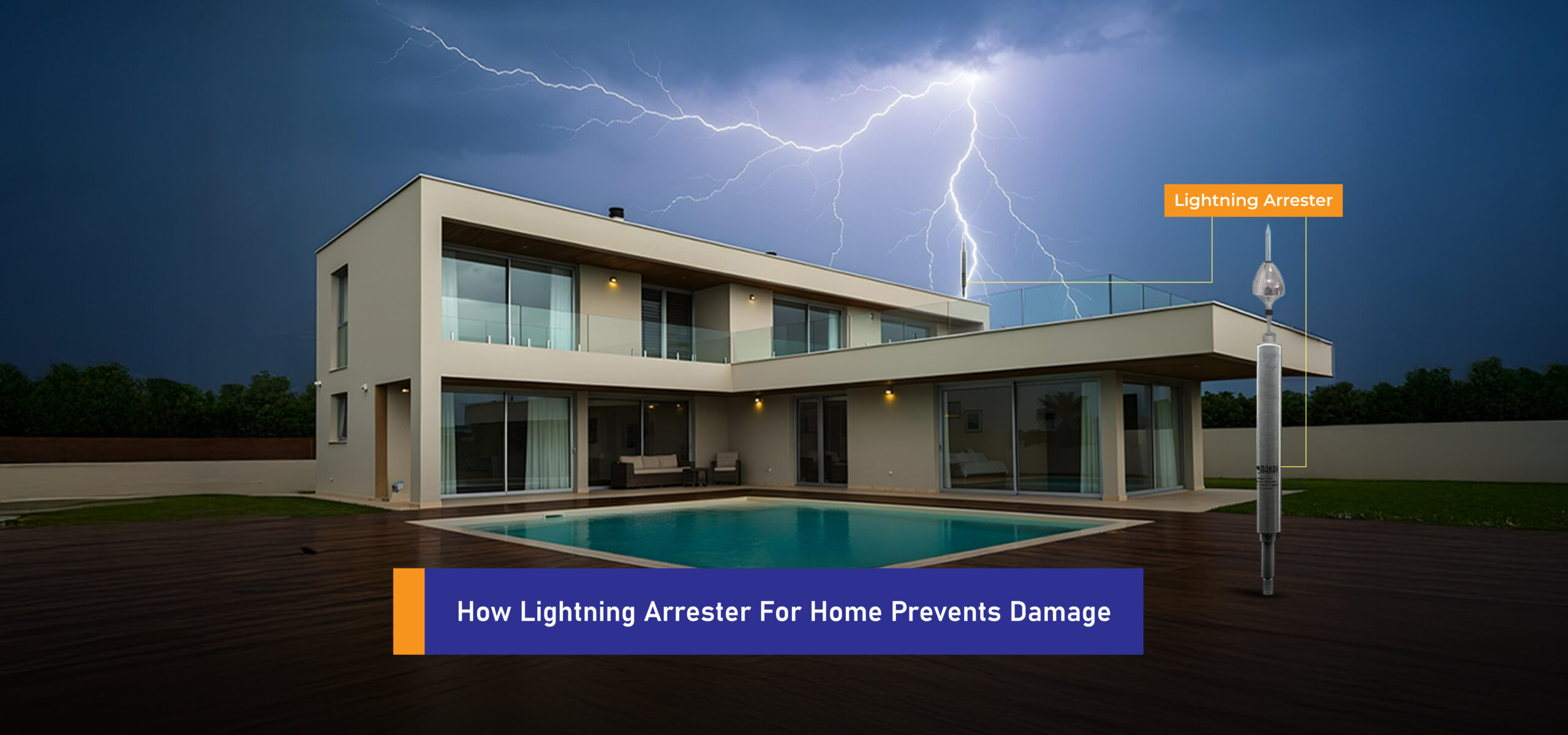What if a single lightning strike could disrupt your entire home or school’s electrical system in seconds? Are you truly prepared to protect yourself and valuable equipment from sudden, devastating surges? With changing climate patterns and rising urban density, the risk is increasing. According to the India Meteorological Department, lightning was responsible for over 2,000 fatalities in a single year, making it one of the deadliest weather-related hazards in the country.
Installing a lightning arrester for home is no longer optional; it’s a crucial step in protecting your family, electronics, and property. Whether it’s a power surge that fries your appliances or a direct strike that damages your rooftop, a proper lightning protection system can make all the difference.
In this blog, we’ll walk you through why lightning protection is essential, how it works, and most importantly, how to install the best lightning arrester for home, so you can stay safe and secure.
What is a Lightning Arrester for Home?
The working principle behind the Lightning arresters is simple but effective. Basically, they consist of a metal rod or conductor that extends from the highest point of your home, in this case, the roof. During a strike, the arrester intercepts the electrical surge and provides the path of least resistance for the current to travel safely into the ground without entering the home’s wiring and appliances, hence avoiding fire and electrical damage.
Lightning Arrester vs. Surge Protector
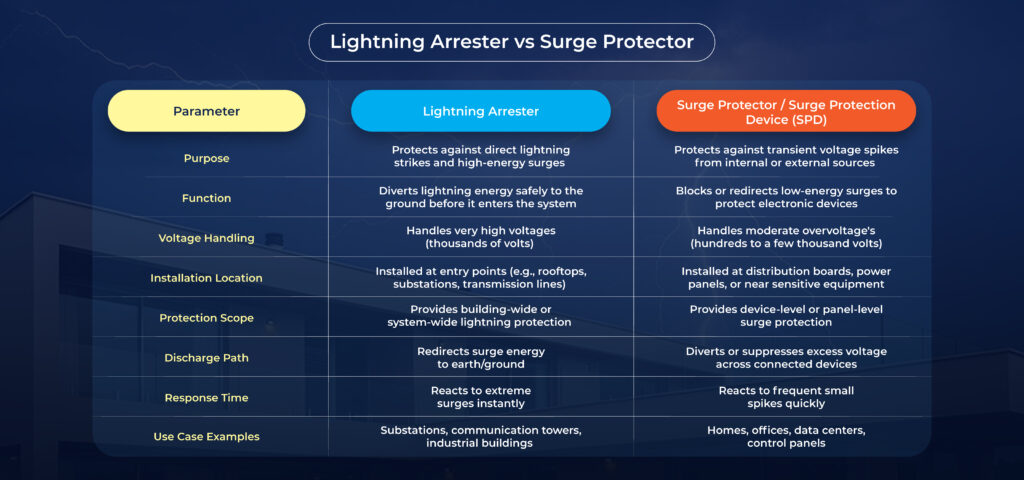
Benefits of installing a lightning arrester for the home
- Protection Against Electrical Surges
The primary advantage of a lightning arrester is that these devices give users protection from electrical surges caused by lightning strikes. Such big surges may cause the frying of sensitive electronics or failure in an HVAC, resulting in very costly repairs. With the installation of a lightning arrester, you will significantly reduce these risks and ensure the longevity of electric-based appliances at home.
- Improved Safety of the Occupants
Besides property protection, a lightning arrester improves the safety of all in your household. Electrical currents potentially travel along plumbing and wiring at the point of a lightning strike, thereby delivering a shock or fire. With an arrester in place, these risks are greatly reduced, thus bringing peace of mind during thunderstorms.
- Building Code Compliance
This design forms the basis of most building codes, with many jurisdictions insisting that homes come equipped with lightning arresters, particularly in regions prone to lightning. In addition to saving your home, this avoids legal liabilities that could come up should damage result from a lightning strike.
5 Components of a Lightning Protection System for Home
- Air Terminals (Lightning Rods): These are installed on the roof to act as the first point of contact for lightning.They help by intercepting the strike and safely directing it away from vulnerable areas of the house.
How it helps: Prevents direct lightning from hitting the structure and starting a fire or causing structural damage.
- Conductor Cables: These are thick metal cables that connect the lightning rods to the grounding system.They provide a controlled, low-resistance path for the lightning current to travel down to the ground.
How it helps: Keeps lightning from passing through walls, electrical wiring, or plumbing where it could cause major damage.
- Grounding Electrodes (Ground Rods): These rods are buried deep in the earth near your home and connected to the conductor cables. They safely disperse the lightning energy into the ground.
How it helps: Reduces the risk of electrical shock, fire, or damage by neutralizing the energy underground.
- Bonding Conductors: These are used to connect all the metallic systems in the house, like gas pipes, water lines, and electrical panels, to the LPS.
How it helps: Prevents dangerous side flashes, where lightning jumps between conductive systems inside the house.
- Surge Protection Devices (SPDs): Installed at the main electrical panel or on individual outlets, these protect electronic devices from voltage spikes.
How it helps: Prevents damage to appliances, computers, TVs, and other electronics by stopping excess voltage from lightning surges.
What is involved with protecting a home from lightning?
Lightning protection system for homes requires more than just a single air terminal (lightning rod) on the roof. Even a small building must have multiple air terminals and earth electrodes (grounds). Between the roof and ground, there must also be conductors to provide multiple safe pathways for the ultra-high voltage lightning to follow. Metallic systems, such as plumbing, electrical wiring, and the structural framework in the building, must be bonded to the lightning protection system. Surge protection devices must also be installed on all electrical and communication lines entering the home.
How to Install a Lightning Arrester for Home?
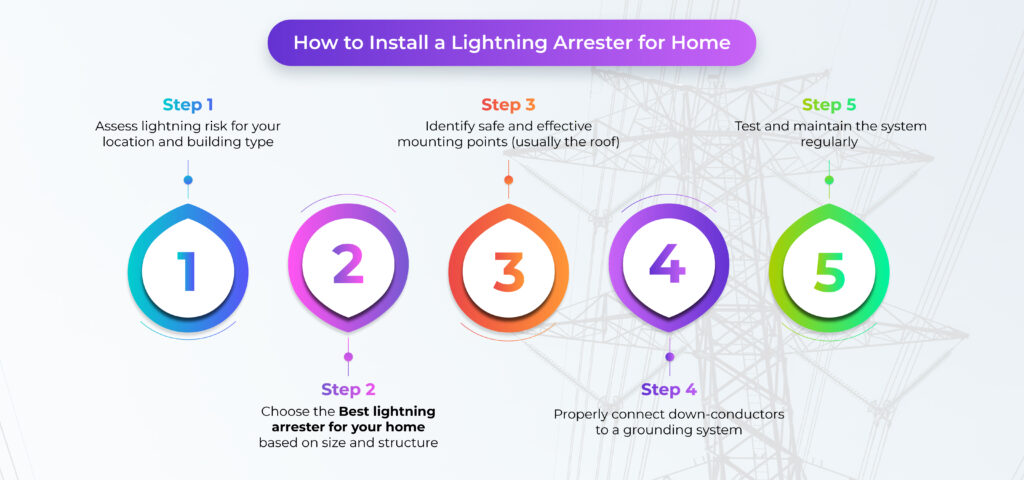
- Step 1: Assess lightning risk for your location and building type
- Step 2: Choose the Best lightning arrester for your home based on size and structure
- Step 3: Identify safe and effective mounting points (usually the roof)
- Step 4: Properly connect down-conductors to a grounding system
- Step 5: Test and maintain the system regularly
Choose the Best Lightning Arrester for Home
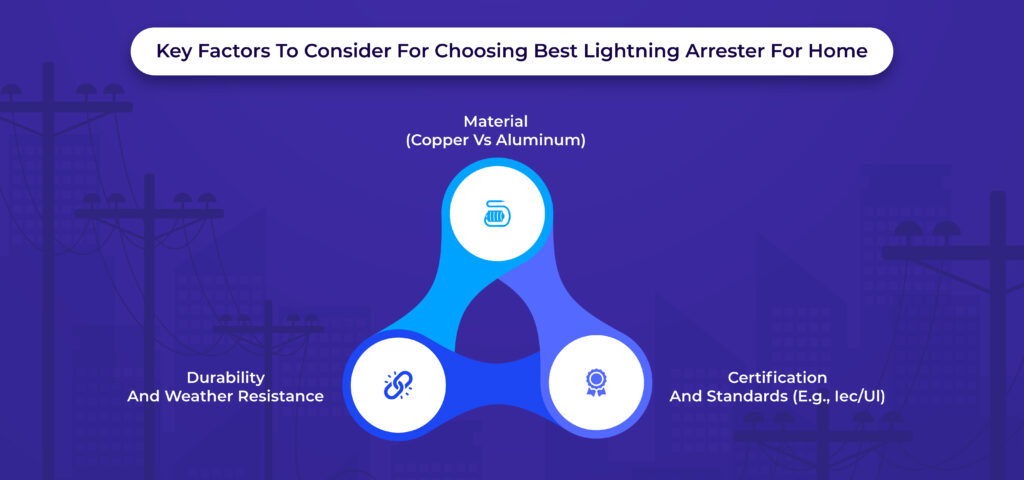
Key factors to consider for choosing best lightning Arrester for home:
- Material (copper vs. aluminum)
- Certification and standards (e.g., IEC/UL)
- Durability and weather resistance
Types of ESE (Early Streamer Emission) Lightning Arrester Installations
- Roof-Mounted Lightning Arrester: Installed on the highest points of buildings to provide direct protection from lightning strikes.
- Wall-Mounted Lightning Arrester: Fixed to the side of structures when roof installation is not feasible or for additional coverage.
- Pole-Mounted Lightning Arrester: Used for open areas or standalone structures, often mounted on tall masts or poles.
- Ground-Mounted Lightning Arrester: Installed at ground level with elevated conductors, typically for open-field protection.
- Integrated Lightning Arrester (with building structure): Uses structural elements (like steel reinforcements) as part of the lightning protection system.
- Temporary or Portable Lightning Arrester: Used in temporary setups like construction sites, events, or outdoor installations.
- Substation-Type Lightning Arrester: Installed in electrical substations or on transmission lines for surge protection.
Common Mistakes to Avoid During Installation of Lightning Arrestors
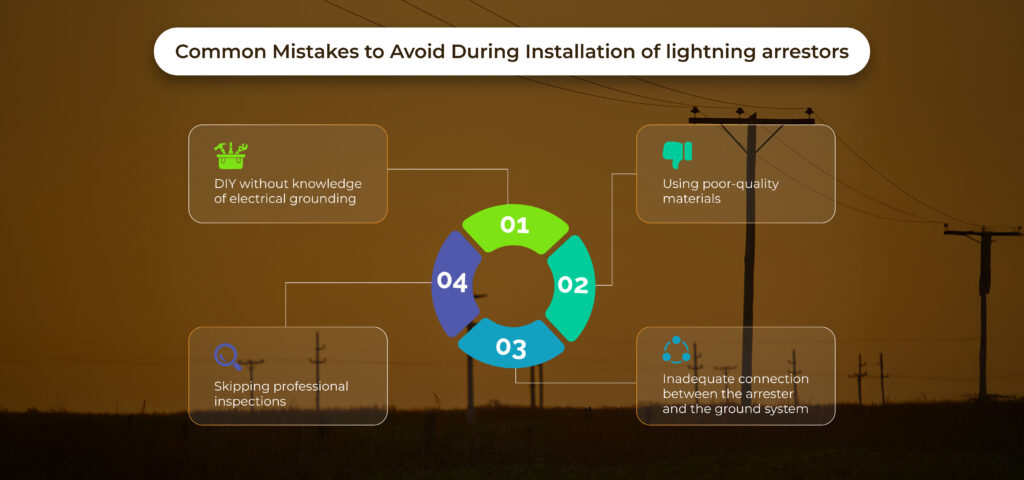
- DIY without knowledge of electrical grounding
- Using poor-quality materials
- Inadequate connection between the arrester and the ground system
- Skipping professional inspections
Conclusion:
In today’s unpredictable climate, such as example- [Karnataka (April–August 2025) – Nearly half of all weather-related deaths in the state ,49 out of 101 fatalities, were due to lightning strike, with the North Karnataka region being particularly affected.]
Installing a lightning arrester for homes is a smart and necessary investment. It not only protects your appliances and electronics from dangerous surges but also ensures the safety of your family and property.
By using a well-designed lightning protection system for homes, including lightning rods, grounding, and surge protection, you significantly reduce the risk of fire, electrical failure, and costly damage.
Choose the best lightning arrester for home by considering your building size, materials, and professional standards. Don’t take shortcuts; a reliable lightning protection system is about long-term safety and peace of mind.
– Author: Niju PP

